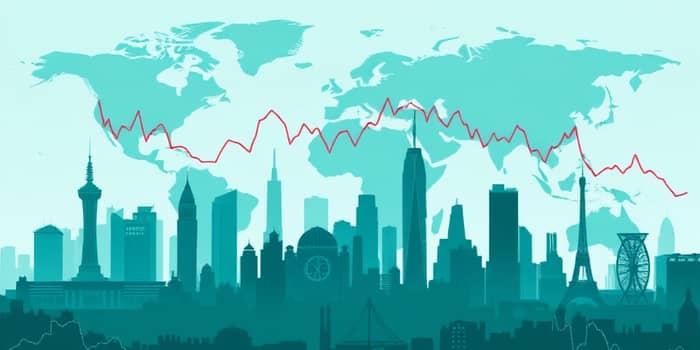
Deflationary pressures are gaining traction in several advanced economies, challenging the narrative of persistent inflation that has dominated recent years. As global growth slows and markets adjust, select regions are now experiencing signs of falling prices, with significant implications for policymakers and investors alike.
In 2025, the world economy is projected to expand by just 2.3%, dipping below the long-term average and flirting with recession thresholds. This slowdown reflects weaker consumer spending, fragile trade dynamics, and the lingering aftershocks of pandemic-era disruptions. While inflation remains elevated in some emerging markets, advanced economies are showing pockets of subdued global economic growth and price softness.
Contrasts are stark: China is slipping into mild deflation, parts of the United States are seeing wholesale prices decline, and the eurozone edges toward disinflation. In this environment, central banks face a delicate balancing act, navigating between stoking demand and preventing a full-blown deflationary spiral.
China’s price indices have turned negative, signaling a fundamental shift from the modest disinflation of 2024 to a more worrying deflationary trend. In May 2025, the Consumer Price Index (CPI) fell by 0.1% year-on-year—the fourth consecutive monthly decline—while the Producer Price Index (PPI) plunged 3.3%, marking the 30th straight month of factory-gate price contractions.
Underlying these data are weak household demand persists, driven by stagnating wages, a soft yuan, and a consumption structure that lags peer economies. Oversupply in manufacturing and faltering export growth have further fueled price declines.
The risk is that consumers and businesses begin to expect falling prices, prompting them to delay purchases and investment. This self-reinforcing dynamic recalls Japan’s late 1990s deflationary trap, raising fears of a prolonged self-reinforcing deflationary cycle.
In response, Beijing has eased monetary policy, cut banks’ reserve requirements, and introduced fiscal incentives to boost consumption. However, the effectiveness of these measures remains uncertain, especially if sentiment fails to improve.
In the United States, consumer inflation remains positive but is losing momentum, while wholesale prices show outright declines. April 2025 saw the Producer Price Index drop 0.5% month-on-month—the largest fall in five years—due largely to lower energy costs and compressed service margins.
Core PPI, which excludes volatile categories such as food, energy, and trade services, fell 0.4% on the month, leaving its annual rate at 3.1%. Meanwhile, the Consumer Price Index climbed only 0.2% in April, translating into a 2.3% year-on-year increase—the lowest since early 2021.
These divergent trends suggest that producers are absorbing rising costs to maintain sales volume, squeezing profit margins. Retailers face similar pressures, and lagging demand could force further price concessions if firms seek to clear inventories.
Complicating the outlook are recent tariff announcements, which could reverse some of the disinflation at the wholesale level by raising input costs. The Federal Reserve’s path is thus clouded by policy uncertainty and the risk of premature rate cuts or hikes.
The eurozone has entered a clear disinflation phase. Inflation is forecast to slow to 0.9% in 2025, down from 2.3% in 2024, reflecting weaker consumer and business spending, as well as corrections in real estate markets.
In the UK, looser fiscal policy and market expectations for rate cuts have bolstered demand, keeping inflation above zero. However, the Bank of England faces a delicate decision: cutting rates risks embedding inflation expectations, while maintaining higher rates could tip the economy toward recession.
Japan stands apart from its peers: after decades of near-deflation, wage growth and fiscal stimulus have pushed inflation close to the Bank of Japan’s 2% target. Incremental policy tightening is expected to continue, reflecting confidence in the economic recovery.
This reflationary backdrop contrasts sharply with China’s slide into price declines, illustrating how structural differences—demographics, labor markets, and monetary frameworks—can yield divergent outcomes.
The emergence of deflationary signals in major economies carries far-reaching implications:
As central banks approach their terminal rates—around 3.5% in the US, 3% in the UK, 2% in the eurozone, and gradual hikes in Japan—their next steps will be critical. A pause may be warranted to assess evolving price dynamics, but vigilance against a deflationary drift is paramount.
Deflationary signals in China and the United States, alongside disinflation in Europe and reflation in Japan, underscore a fragmented global economy in mid-2025. Policymakers must balance growth support with inflation anchoring, while businesses adapt to squeezed margins and surprising price moves.
For investors and corporate leaders, the era of predictable inflation may be over. Strategic agility, rigorous scenario planning, and a clear understanding of regional divergences will be essential to thrive in an environment where deflation and inflation coexist across borders.
References













